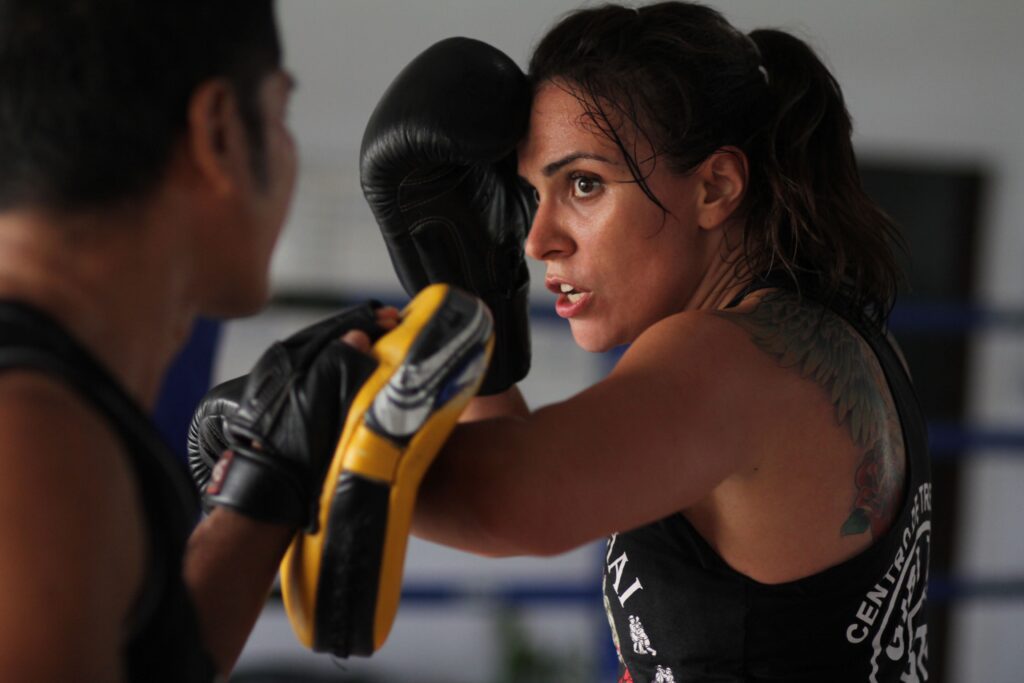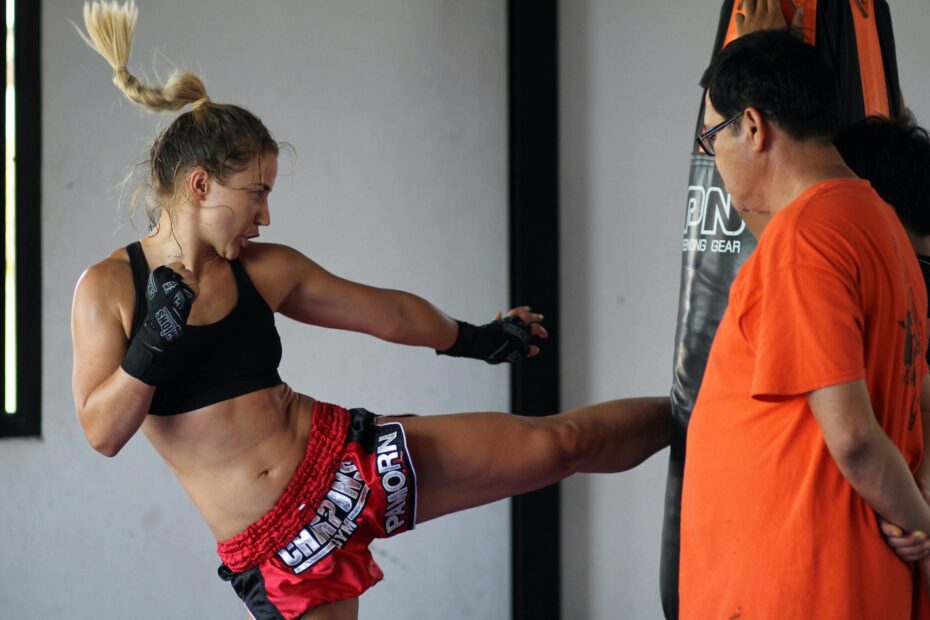
Muay Thai is one of the most popular combat sports in the world. By following the physical conditioning tips in this blog post, you can improve your performance as a Muay Thai fighter. Being in the best shape possible helps you focus more on technique and enjoy classes. You’ll quickly find that physical conditioning for Muay Thai can be very sport-specific and is a necessary part of improving. Before we jump into physical conditioning tips for Muay Thai, we’ll briefly cover what Muay Thai is.
What is Muay Thai?
Also known as the art of 8 limbs, Muay Thai is a striking art with its roots in Thailand. This martial art is known for its brutality and effectiveness both in competition and in self-defense situations. Techniques from Muay Thai are used in other sports such as Mixed Martial Arts such as checking kicks and utilizing elbows in short distances.
Muay Thai also encourages a high level of physical conditioning, which helps practitioners become more agile, powerful, and resilient. The use of clinch techniques and powerful strikes help practitioners fight effectively. Regular practice of these techniques helps to improve coordination and balance, allowing Muay Thai fighters to have better control over their techniques.
The history of Muay Thai
The beginnings of Muay Thai go as far back at the 16th century in Thailand. It was used by members of King Naresuan’s military in combat. Muay Thai gained traction and popularity since it was used in war as well as sport situations.
In the early 1900s, King Chulalongkorn increased the use of Muay Thai through the formalization of the fighting style. Eventually, detailed rules were decided on by 1921 with the first boxing ring built thanks to the influence of King Rama VII. Muay Thai eventually began to grow as a sport with the introduction of gloves and groin protectors.
Global growth of Muay Thai
The 1980s and 1990s were great decades for Muay Thai as gyms began to pop up around the world. Non-Thai fighters began to travel into Thailand to learn the art. As a result, Muay Thai fighter development accelerated and Muay Thai grew even more in popularity. Muay Thai techniques are no longer just limited to being used in Muay Thai gyms and Muay Thai competition.
Is Muay Thai used in MMA?
Yes, Muay Thai techniques are often used by MMA fighters. Striking techniques that are often used include elbows and knees. MMA fighters will also fight within the clinch which is a technique heavily used by Muay Thai fighters. The clinch is a powerful move that allows a fighter to effectively control the posture of his/her opponent in a fight.
Here’s a video showing a Muay Thai clinch technique for MMA:
Now that you know a little more about Muay Thai and its history, let’s move on to conditioning tips specifically for Muay Thai.
5 physical conditioning tips for Muay Thai
Getting in shape to be the best Muay Thai fighter you can be is tough. The best fighters in the world got to where they are today because they put in the work required to accomplish their goals. Below are 5 physical conditioning tips for Muay Thai you can add to your training regimen:
- Attend class consistently: It’s tough to stay in shape when you’re skipping class. Muay Thai classes will teach you more than just striking and defense. You’ll also do heavy bag work which will help you develop power. You will also do conditioning sessions like ab work, burpees, and more to strengthen your entire body and increase your lung capacity.
- Don’t skip sleep: Performing at the top of your game is easier when you’re getting proper rest. Whether it’s 7 hours or 8 hours, figure out what’s best for you and try to piece at least 2-3 days in a row of adequate sleep. It’s during these sustained sleep periods that your body is able to repair and rebuild muscle. Your brain will also commit energy to practicing moves in and walking through techniques you’ve learned as you sleep.
- Drink water and stay hydrated: You can’t be at your best when you’re dehydrated. Hydration provides multiple benefits including improved brain performance, better digestion, less joint pain, and more. Your body is also able to get rid of waste more efficiently. This will help you stay healthy and not get sick as often.
- Listen to your body: When your body tells you that you need a break, take that break. Injuries can be prevented when you pay attention to and address pain. Rest and recovery will be your best friend when you’re working hard. You may feel like you’re missing out on valuable training opportunities but you’ll definitely miss out on more when you’re injured because you weren’t listening to your body.
- Invest in your strength, mobility, and cardio: The best fighters in the world continually work on their strength and ability to move. Strength combined with proper technique will make you a tough opponent in the ring. Anyone who tells you strength doesn’t matter is lying to you since increasing your strength also helps you avoid injuries. Exercises such as weight training and plyometrics will help you develop stronger bones, muscles, and ligaments. For cardio, you can improve your aerobic/anaerobic capacity in different ways such as sprints, swimming, cycling, and long distance runs. A consistent conditioning schedule will help you be at your best all the time.
There’s a good chance you may already be following some of the tips above which is great. If not, it’s time to get started. Making a few changes to your daily routine will help you feel the difference over time. For example, you’re probably not feeling your best if you only get great sleep twice a week. However, increasing your quality sleep to 3 times a week will help you heal faster and be ready for your next training session. Following good habits consistently over time will yield to positive results you’ll get to enjoy!
Go train!
Your journey to becoming the best you can be begins when you start training. Consistent training over time will help you improve your skillset as a fighter. Sticking to a training plan will also keep you on track with your fitness goals for Muay Thai. As a result of improving your physical conditioning, both classes and sparring will be more enjoyable. You’ll have more fun doing Muay Thai since you’re not as concerned with simply keeping up since you’re not constantly gasping for air.
If you haven’t started training, it’s time to find a Muay Thai gym near you! This next section will provide you with tips to choose the right Muay Thai gym for you.
How to choose a Muay Thai gym for you
Finding the right Muay Thai gym for you and your needs does matter. Muay Thai is already a grind so you don’t need to make it more difficult by joining a gym that you don’t like. Here are a few factors to consider when choosing a Muay Thai gym:
- Location: You can quickly find Muay Thai gyms near you by conducting a quick search of Muay Thai gyms in your area via Google Maps. Google Maps will give you the distance between you and the gyms you want to try out.
- Gym focus: Does the gym you’re interested in joining focus on self-defense, fitness, or training amateur/professional fighters? Some gyms might do some of each. Other gyms are only focused on the fitness aspect. Knowing your goals will help you figure out which gym is for you.
- Fees: Identify your budget on what you want to spend on Muay Thai tuition each month. Many Muay Thai gyms charge around $100-200 USD/month for full access to their classes. If a monthly contract doesn’t make sense for you, some gyms offer punch passes where you pay for individual classes. Punch pass pricing may be about $150 for 10 classes or $175 for 10 classes depending on the gym. You also need to factor in if the gym you want to join includes training gear when you sign up or if you need to bring your own gear to class.
- Teaching/coaching style: Every coach has different style and philosophy to training and teaching concepts. Some Muay Thai coaches are intense the entire class. Other Muay Thai coaches may be soft spoken and never raise their voice during all of their training sessions. You also need to pay attention to the number of coaches on the gym floor at any time and how collaborative the learning process is within a gym.
- Teammates: How are the people attending each class? What’s their temperament like? Do the personality types vary depending on the time of day i.e. evening classes vs. morning classes? Pay attention to how helpful people are and how friendly they are.
- Cleanliness: Dirty gyms are disgusting. You’re more likely to get sick which will cause you to miss training sessions. Muay Thai gyms that are clean are also more likely to have equipment that’s in great shape. Coaches at clean gyms also tend to be more detail-oriented.
Do you have any questions or insights on conditioning for Muay Thai? Let us know in the comments below!
